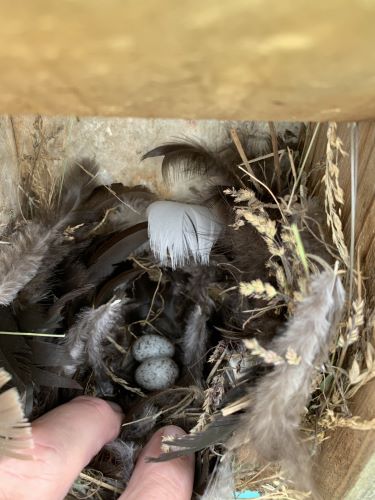Participant Photos
upload and share photos
Photo Submission
Submitted By
DARRELL GAMMON
Deerfield, OH, USA
Description
I have a bluebird nest box with a 2 inch hole that I found this unidentified bird. I thought it was an American kestrell but they don’t add material and this nest has some long grass stocks with a cup made of all black feathers. Can anyone tell me what this nest is? I’m about to get a game camera to post nearby to help find the identification of the bird but thought I would ask this community first.
Category
Tags
Continue Browsing
Tag:











Hmm, my guess would be House Sparrow. I thought maybe a chickadee but the feathers.
Thanks for your thought but, this nest is not woven circular like a house sparrow, but black feathers are in a cup formation, that’s why I was think not a HS. I’m thinking of buying a game camera to mount nearby the box.
Tree swallow??
Can’t be a tree swallow ’cause the eggs are speckled and swallows are white plus these are larger than swallow eggs
I think the most likely explanation is that the nest is a Tree Swallow’s nest but the eggs are Brown-Headed Cowbird eggs.
Even if they are do NOT remove them. To do so is a prison-worthy crime of up to 1 year. Cowbirds are protected by the migratory bird treaty.
On the 3rd of July, the MBTA was signed in like the 1980’s.
Also, please don’t put your fingers on the nest. It is illegally protected.
Sorry, I meant legally
Hey folks, this is a House Sparrow nest. House Sparrow nests are quite messy and there’s often variation between individuals (not all will have a neatly woven cup). They use all kinds of materials, such as dried vegetation, feathers, string, and paper. Their eggs are indeed a bluish-green with the brown or gray spotting – similar to a cowbird which can make it difficult to identify, but it’s somewhat uncommon to find a nest with only cowbird eggs inside. American Kestrels are much larger birds, and need a larger box with an entrance hole of at least 3-4 inches in diameter; their eggs are brownish, round, and much larger than songbird eggs.